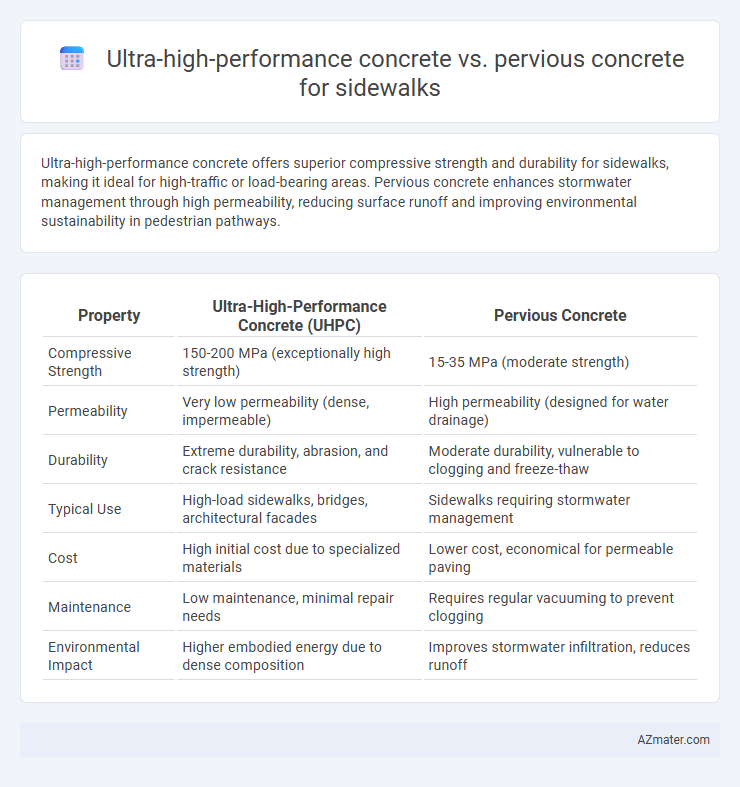Ultra-high-performance concrete offers superior compressive strength and durability for sidewalks, making it ideal for high-traffic or load-bearing areas. Pervious concrete enhances stormwater management through high permeability, reducing surface runoff and improving environmental sustainability in pedestrian pathways.
Table of Comparison
| Property | Ultra-High-Performance Concrete (UHPC) | Pervious Concrete |
|---|---|---|
| Compressive Strength | 150-200 MPa (exceptionally high strength) | 15-35 MPa (moderate strength) |
| Permeability | Very low permeability (dense, impermeable) | High permeability (designed for water drainage) |
| Durability | Extreme durability, abrasion, and crack resistance | Moderate durability, vulnerable to clogging and freeze-thaw |
| Typical Use | High-load sidewalks, bridges, architectural facades | Sidewalks requiring stormwater management |
| Cost | High initial cost due to specialized materials | Lower cost, economical for permeable paving |
| Maintenance | Low maintenance, minimal repair needs | Requires regular vacuuming to prevent clogging |
| Environmental Impact | Higher embodied energy due to dense composition | Improves stormwater infiltration, reduces runoff |
Introduction to Sidewalk Concrete Types
Ultra-high-performance concrete (UHPC) offers exceptional durability, high compressive strength exceeding 150 MPa, and enhanced resistance to weathering, making it ideal for long-lasting sidewalk surfaces in high-traffic urban areas. Pervious concrete provides permeability rates up to 1,200 inches per hour, facilitating stormwater management and reducing runoff by allowing water to infiltrate through the pavement, which supports sustainable sidewalk design. Selecting between UHPC and pervious concrete depends on project priorities such as structural performance, lifespan, and environmental impact for effective sidewalk construction.
What is Ultra-High-Performance Concrete (UHPC)?
Ultra-High-Performance Concrete (UHPC) is a highly durable and dense composite material characterized by its superior strength, enhanced durability, and low permeability, making it ideal for sidewalks subjected to heavy traffic and harsh environmental conditions. UHPC incorporates fine powders, silica fume, and fiber reinforcements, resulting in compressive strengths exceeding 150 MPa and exceptional resistance to abrasion and freeze-thaw cycles. Unlike pervious concrete, UHPC provides a dense, impermeable surface that prioritizes longevity and structural integrity over water permeability.
What is Pervious Concrete?
Pervious concrete is a porous material designed to allow water to pass through its surface, reducing runoff and promoting natural groundwater recharge, making it well-suited for environmentally sustainable sidewalks. Unlike ultra-high-performance concrete, which emphasizes strength and durability with low permeability, pervious concrete prioritizes permeability and stormwater management while providing adequate structural integrity for pedestrian use. Its open-graded mix of cement, coarse aggregates, and little or no sand creates interconnected voids that enable efficient water drainage.
Strength and Durability Comparison
Ultra-high-performance concrete (UHPC) exhibits compressive strengths exceeding 150 MPa and exceptional durability due to its dense microstructure, making it highly resistant to abrasion, freeze-thaw cycles, and chemical attacks, ideal for high-traffic sidewalks requiring long-term performance. In contrast, pervious concrete typically has compressive strengths between 10 to 30 MPa and offers enhanced water permeability but compromises load-bearing capacity and durability in freeze-thaw environments. The superior strength and durability of UHPC significantly extend the lifespan of sidewalks compared to the more porous, less robust nature of pervious concrete.
Permeability and Water Management
Ultra-high-performance concrete (UHPC) offers exceptional strength and durability but exhibits very low permeability, limiting its effectiveness in natural water drainage and increasing runoff on sidewalks. Pervious concrete, engineered with high porosity, allows water to infiltrate through the pavement surface, significantly improving stormwater management and reducing surface runoff. Selecting pervious concrete for sidewalks enhances groundwater recharge and minimizes urban flooding risks, making it superior for sustainable water management compared to non-permeable UHPC.
Installation and Maintenance Requirements
Ultra-high-performance concrete (UHPC) requires specialized installation techniques, including skilled labor and precise curing conditions, leading to higher upfront costs but ensuring exceptional durability and low maintenance over time. Pervious concrete installation demands careful mix design and placement to maintain its permeability, with routine cleaning needed to prevent clogging and maintain drainage efficiency. Maintenance for UHPC sidewalks is minimal due to its dense microstructure and resistance to wear, whereas pervious concrete requires periodic vacuuming or pressure washing to sustain its porosity and performance.
Environmental Impact and Sustainability
Ultra-high-performance concrete (UHPC) offers exceptional durability and strength, reducing the need for frequent repairs and material consumption, thereby lowering its overall environmental footprint over time. Pervious concrete enhances groundwater recharge and mitigates urban heat island effects by allowing water infiltration, promoting sustainable stormwater management. Choosing between UHPC and pervious concrete depends on balancing long-term durability benefits with ecological advantages in sidewalk applications.
Cost Analysis and Budget Considerations
Ultra-high-performance concrete (UHPC) for sidewalks offers superior strength and durability but comes with a significantly higher initial cost, often exceeding $200 per cubic yard compared to $100-$150 for pervious concrete. Pervious concrete provides benefits in stormwater management and environmental compliance but may incur additional maintenance costs due to clogging and reduced lifespan. Budget considerations must weigh upfront material and installation expenses of UHPC against the lifecycle costs and environmental benefits of pervious concrete to determine long-term value.
Best Use Cases for Each Concrete Type
Ultra-high-performance concrete (UHPC) is ideal for sidewalks requiring exceptional durability, high compressive strength, and resistance to harsh weather or heavy pedestrian traffic, ensuring a long lifespan with minimal maintenance. Pervious concrete excels in applications where stormwater management and environmental sustainability are priorities, allowing water to permeate through the pavement, reducing runoff and supporting groundwater recharge. Selecting UHPC is best for urban areas with heavy wear, while pervious concrete suits green infrastructure projects and environmentally sensitive zones.
Choosing the Right Concrete for Sidewalks
Ultra-high-performance concrete (UHPC) offers superior durability, compressive strength up to 150 MPa, and exceptional resistance to weathering, making it ideal for high-traffic sidewalks requiring minimal maintenance. Pervious concrete enhances stormwater management by allowing water infiltration, reducing runoff, and promoting groundwater recharge, suitable for eco-friendly urban sidewalks in areas prone to flooding. Selecting the right concrete depends on balancing load-bearing requirements, environmental factors, and long-term maintenance costs specific to sidewalk applications.

Infographic: Ultra-high-performance concrete vs Pervious concrete for Sidewalk
 azmater.com
azmater.com